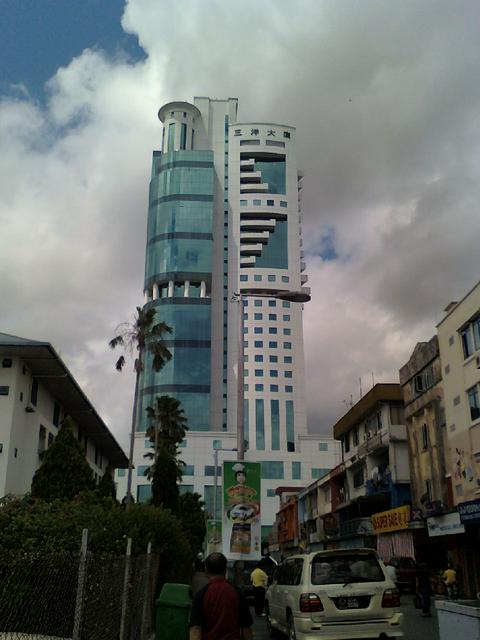 Sibu is a town in Sarawak, East Malaysia. It's not much of a tourist destination itself (though it does have some beautiful Chinese temples), but it's a common transfer point for boats up the Rejang River to the small towns of Borneo's interior.
Sibu is a town in Sarawak, East Malaysia. It's not much of a tourist destination itself (though it does have some beautiful Chinese temples), but it's a common transfer point for boats up the Rejang River to the small towns of Borneo's interior.
Garden City to be, this is a quiet town along Rejang River. Sibu is one of the three towns in Malaysia which consists of a predominantly Foochow-Chinese population (Yong Peng in Johor and Sitiawan in Perak are the others). Sibu is not only famous for food (such as Kompia, Kampua and the like), but also boasts of being the hometown of a national patriot called Rosli Dhoby. The town symbol is the Swan. Unofficially, Sibu has been coined the 'Wild West' of Malaysia and the term has existed for more than 20 years. The nickname came about due to the nature of 'lawlessness' and frequent triad activities in Sibu.
There's a visitor information centre at the Sibu Cultural Heritage Museum on Jalan Central.
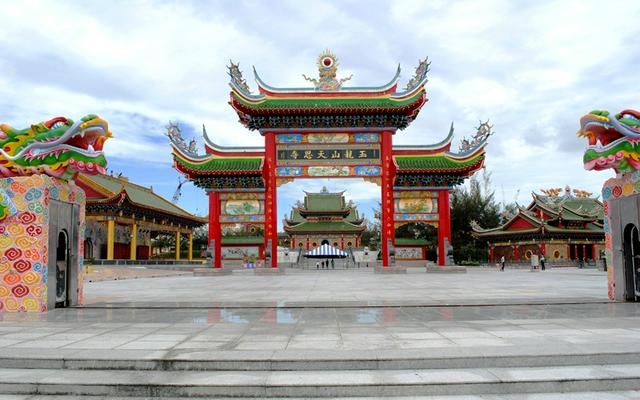
- Tua Pek Kong Temple. A must see in Sibu. Its history dates back to 1870. Better go around sunset and ask the key to go to the topfloor of the tower for a fantastic view of Sibu and the river.
- Sibu Town Square. The largest town square in Malaysia. Once here, you may walk to the waterfront(at the end of the square) and see the confluence of two great rivers, the Rajang and the Igan. This waterfront is popular for the locals to hang out and also for recreational purposes.
- Lau King Howe Hospital Memorial Museum.
- Sibu Central Market. The largest indoor market in Malaysia. Lots of local things can be bought here. Do not miss to try the food at the 1st floor of the market. Also there is a very affordable attire sold on the 1st floor.
- Bukit Aup Jubilee Park. The popular attraction of the park is its lake, which have lots of fish and you can feed them. Also, the park is popular for hiking. Once you reach the top of the hill, you can enjoy the view of Igan river and the town. The hill is the highest point in Sibu, and it has a cemetery and an indigenous religious site.
- Sibu Lake Park. The park comprises an area of 11 acres lake, footpaths, jogging tracks, boat house, habitat island, bird sanctuary, barbeque and picnic areas, spash pool, canteen, jetty and others.
- Sungai Merah Heritage Walk. Built to commemorate the arrival of 100 years of the Foochows immigration to Sibu. See the red colored water of the river.
- Sibu Heritage Center.
- Yu Long Shang Tian En Shi. The temple is dedicated to three faiths: Buddhism, Taoism and Confucianism.
- Tan Hua Hu Temple, Jalan Bukit Assek. A beautiful Chinese temple with intricate designs.
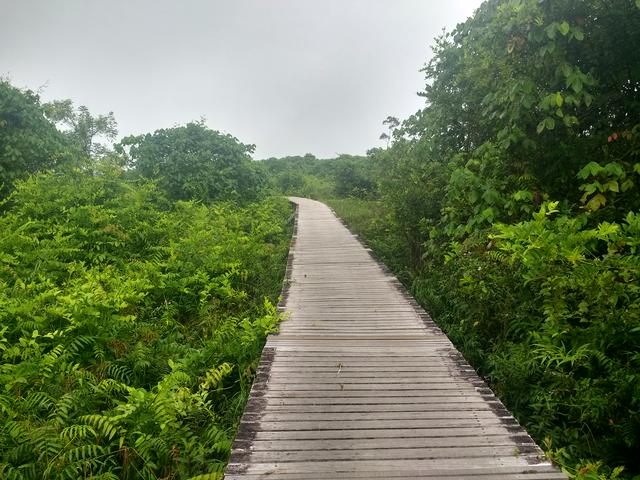
- Bukit Lima Nature Reserve. A chunk of swampy jungle conserved within the city limits. It includes a couple of trails – actually boardwalks – that are popular for jogging. The longer route is about 5 km, along which you can see lots of plants, birds, and insects, and maybe lizards, small mammals, and even monkeys if you're lucky. Be careful if jogging, because the path can be slippery. Free.
Tua Pek Kong Temple. A must see in Sibu. Its history dates back to 1870. Better go around sunset and ask the key to go to the topfloor of the tower for a fantastic view of Sibu and the river.
Sibu Town Square. The largest town square in Malaysia. Once here, you may walk to the waterfront(at the end of the square) and see the confluence of two great rivers, the Rajang and the Igan. This waterfront is popular for the locals to hang out and also for recreational purposes.
Lau King Howe Hospital Memorial Museum.
Sibu Central Market. The largest indoor market in Malaysia. Lots of local things can be bought here. Do not miss to try the food at the 1st floor of the market. Also there is a very affordable attire sold on the 1st floor.
Bukit Aup Jubilee Park. The popular attraction of the park is its lake, which have lots of fish and you can feed them. Also, the park is popular for hiking. Once you reach the top of the hill, you can enjoy the view of Igan river and the town. The hill is the highest point in Sibu, and it has a cemetery and an indigenous religious site.
Sibu Lake Park. The park comprises an area of 11 acres lake, footpaths, jogging tracks, boat house, habitat island, bird sanctuary, barbeque and picnic areas, spash pool, canteen, jetty and others.
Sungai Merah Heritage Walk. Built to commemorate the arrival of 100 years of the Foochows immigration to Sibu. See the red colored water of the river.
Sibu Heritage Center.
Yu Long Shang Tian En Shi. The temple is dedicated to three faiths: Buddhism, Taoism and Confucianism.
Tan Hua Hu Temple, Jalan Bukit Assek. A beautiful Chinese temple with intricate designs.
Bukit Lima Nature Reserve. A chunk of swampy jungle conserved within the city limits. It includes a couple of trails – actually boardwalks – that are popular for jogging. The longer route is about 5 km, along which you can see lots of plants, birds, and insects, and maybe lizards, small mammals, and even monkeys if you're lucky. Be careful if jogging, because the path can be slippery. Free.
Visit the local Sibu Central Market. Local products can be found extensively such as local olives, exotic fruits and vegetables as well as some handicraft.
Do not miss out on the action in Sibu Night Market in the evening till midnight every day. You can get anything here. From delicious Chinese food, Malay delicacies and bargain for attire. It is said that the night market in Sibu is the liveliest in Sarawak.
Bars and pubs, often occupied by the regular patrons. Take caution of shady characters. Do not stare back when looked at.
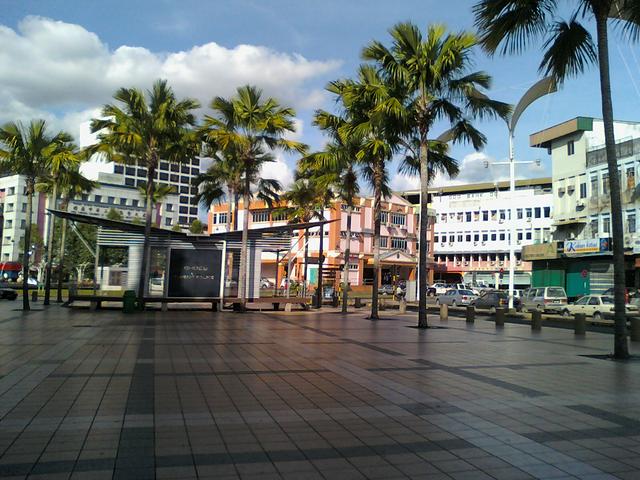 Wisma Sanyan A fairly comprehensive shopping mall located inside the tallest building in Sibu, Wisma Sanyan. Main tenants here are Ria by Parkson, Giant, KFC, and Pizza Hut.
Wisma Sanyan A fairly comprehensive shopping mall located inside the tallest building in Sibu, Wisma Sanyan. Main tenants here are Ria by Parkson, Giant, KFC, and Pizza Hut.
Sarawak House A small mall with a department store on the 1st floor, and various small shops on the ground floor. Located adjacent to Premier Hotel. There is a Watson's outlet, and a handicraft shop here.
Medan Mall A mall with main outlet such as Medan Departmental Store. There are lots of hair saloon here(Ground Floor) and the price for a hair cut is very cheap.
Kin Orient Plaza (old Sing Kwong)
Farley There are many outlets, although all are Farley outlets, but there are bakery, shoes outlet, departmental store, and supermarket. There is also Farley Food Court and Farley Restaurant nearby.
New Sing Kwong (opposite Farley) houses a supermarket, departmental store, and some small outlets. Also here there is KFC, Pizza Hut, and a Watson's store.
Delta Mall A small mall located at Jalan Pahlawan. The mall is NOT in a walking distance from downtown. You may use taxi or local bus to bring you here. Tenants here include; Hush Puppies, SenQ, Giordano, KFC, Popular Bookstores, and etc.
Star Mega Mall The largest mall in Central Region of Sarawak. The anchor tenant is Daesco. Recently soft-opened.
Giant Hypermarket Located at Jalan Ling Kai Cheng.It is one of the newest addition of shopping venues in Sibu. Houses Giant, Giordano, SugarBun, LeaCentre, and et cetera.
- Chai Pau: Vegetable buns, with varieties of vagetables as ingredients was a common dim-sum for hawkers and other blue-collars. Chai Pau is so different with others because of its delicious vegetables contents and less flour on its outer.
- Diang Biang Hu: As is called by local Foochow, 'Diang' is wok, 'Biang' is side, 'Hu' is porridge prepared with grinded rice. So Diang Biang Hu is a rice-grinded-poridge cooked on the surface of a heated wok. Most Foochow pronounce it as Diang Miang Hu.
- Kampua Mieng: In Foochow, it means mee or noodles on a dry plate. The Mieng (noodles), usually oily nature, is soaked in boiling water for a while, is then brought on ingredient (usually fried onion and sauce) application prepared on a plate. The plain Kampua Mieng has no red-pork-slice added, is usually cheaper. Kampua Mieng is sold at most coffee shops and restaurants in Sibu District. Price varies from RM2.20 per plate from coffee shop to RM 5.00 per plate at restaurant.
- Kong Piang: In Foochow dialect, 'Kong' is pottery flask, 'Piang' is biscuit. The traditional way of making Kong Piang is in a charcoal 'oven'. The pre-mixed flour, usually glazed with peanut oil and lightly dusted with sesame seed on the surface with a small hole in the middle, is sticked on the inner surface of the pottery flask. The pottery flask has a narrow mouth, a big mid-section and bottomless. After 15 minutes of charcoal heating, the delicious Kong Piang is ready for meal. Kong Piang is available at some bakeries and eateries. It's available either hard or soft. May come with meat fillings.
- Red Wine Chicken: This unique blend of red wine is a tradition among Foochow people. In the olden days, the family of a pregnant woman would start brewing red wine months prior to the birth of her new child. The ingredients consist of rice, yeast and varieties of herbs. The red wine thus brewed is dense, and is kept in bottles stored in a dry and warm place. Red wine is a vital ingredient to longevity noodles/rice vermicelli (chang shou mian)and pre-cooked chicken which is served to friends and relatives who pay congratulatory visit to the family with new born baby. Red wine is also consumed by the woman who give birth to the baby in the believe that it will help her to recover health in shorter period of time. Nowadays red wine is commonly used as an ingredient for longevity noodles/rice vermicelli with pre-cooked chicken in many traditional Foochow restaurants due to high customers' demand. Besides Red wine chicken, Sibu is well known for Red cao chicken. 'Cao' is the residue of wine.
Chai Pau: Vegetable buns, with varieties of vagetables as ingredients was a common dim-sum for hawkers and other blue-collars. Chai Pau is so different with others because of its delicious vegetables contents and less flour on its outer.
Diang Biang Hu: As is called by local Foochow, 'Diang' is wok, 'Biang' is side, 'Hu' is porridge prepared with grinded rice. So Diang Biang Hu is a rice-grinded-poridge cooked on the surface of a heated wok. Most Foochow pronounce it as Diang Miang Hu.
Kampua Mieng: In Foochow, it means mee or noodles on a dry plate. The Mieng (noodles), usually oily nature, is soaked in boiling water for a while, is then brought on ingredient (usually fried onion and sauce) application prepared on a plate. The plain Kampua Mieng has no red-pork-slice added, is usually cheaper. Kampua Mieng is sold at most coffee shops and restaurants in Sibu District. Price varies from RM2.20 per plate from coffee shop to RM 5.00 per plate at restaurant.
Kong Piang: In Foochow dialect, 'Kong' is pottery flask, 'Piang' is biscuit. The traditional way of making Kong Piang is in a charcoal 'oven'. The pre-mixed flour, usually glazed with peanut oil and lightly dusted with sesame seed on the surface with a small hole in the middle, is sticked on the inner surface of the pottery flask. The pottery flask has a narrow mouth, a big mid-section and bottomless. After 15 minutes of charcoal heating, the delicious Kong Piang is ready for meal. Kong Piang is available at some bakeries and eateries. It's available either hard or soft. May come with meat fillings.
Red Wine Chicken: This unique blend of red wine is a tradition among Foochow people. In the olden days, the family of a pregnant woman would start brewing red wine months prior to the birth of her new child. The ingredients consist of rice, yeast and varieties of herbs. The red wine thus brewed is dense, and is kept in bottles stored in a dry and warm place. Red wine is a vital ingredient to longevity noodles/rice vermicelli (chang shou mian)and pre-cooked chicken which is served to friends and relatives who pay congratulatory visit to the family with new born baby. Red wine is also consumed by the woman who give birth to the baby in the believe that it will help her to recover health in shorter period of time. Nowadays red wine is commonly used as an ingredient for longevity noodles/rice vermicelli with pre-cooked chicken in many traditional Foochow restaurants due to high customers' demand. Besides Red wine chicken, Sibu is well known for Red cao chicken. 'Cao' is the residue of wine.
- New Capitol Restaurant, 46 Jln Kampung Nyabor. 11:00am-2:00pm 5:00pm-9:00pm. RM10-30.
- Warung, Jalan Bandong, +63 14-6935429. 8.30am-11.30pm. Serves a variety of local Halal Malaysian dishes. New Hits Menu: Nasi Ayam Dara Must try: Nasi Goreng Seafood, Nasi Goreng Warung, Tom Yam Kung, Steam Fish, Vege's, Sup Tulang, and many other choices. They also provide catering services for weddings and other occasions. This restaurant is always packed almost every day, so be sure to get there extra early to secure a seat.
New Capitol Restaurant, 46 Jln Kampung Nyabor. 11:00am-2:00pm 5:00pm-9:00pm. RM10-30.
Warung, Jalan Bandong, +63 14-6935429. 8.30am-11.30pm. Serves a variety of local Halal Malaysian dishes. New Hits Menu: Nasi Ayam Dara Must try: Nasi Goreng Seafood, Nasi Goreng Warung, Tom Yam Kung, Steam Fish, Vege's, Sup Tulang, and many other choices. They also provide catering services for weddings and other occasions. This restaurant is always packed almost every day, so be sure to get there extra early to secure a seat.
Do not miss to try the famous Teh C Special. It is available in most kopitiams. It is a three-layered drinks, tea, milk and flavour (available in Pandan and Gula Apong flavors).
Gossip is an endemic problem in Sibu. It can be difficult to escape unwanted and intrusive attention but keeping a low profile can help to reduce the extent of this problem.
There are many shady characters in Sibu, whom one must avoid at all costs.
Gangsterism is a problem in Sibu; most of the gangs are probably connected with some of the numerous timber barons in the town.
Be on high alert while walking, especially at Sibu Central Market. The risk of being pick-pocketed is high,as there are several cases involving the customers and also shop owners being pick-pocketed. Should you have been pick-pocketed, go to the nearest Tourist Police Station, not far from the Central Market.
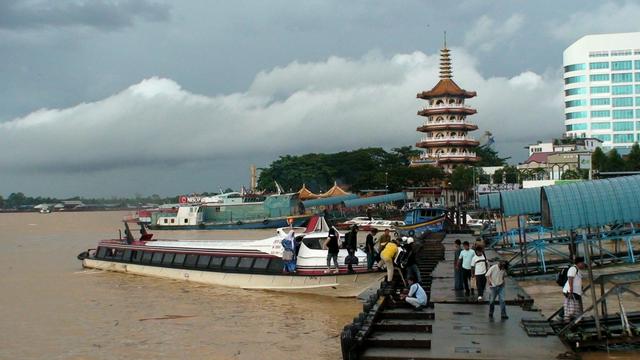 The Sibu River Wharf enables access to the interior towns further up the Rejang River. You can reach the towns of Kapit and Belaga (which is the most extreme part navigable on the Rejang River).
The Sibu River Wharf enables access to the interior towns further up the Rejang River. You can reach the towns of Kapit and Belaga (which is the most extreme part navigable on the Rejang River).
